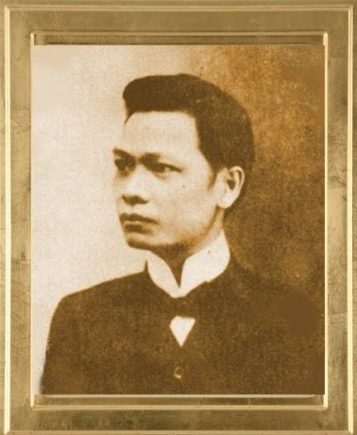Tahanan ng mga Katipunero
Home of Heroes of the 1896 Revolution
Ang Mga Maybahay
They Lived Here

Julio Nakpil
(22 May 1867 –
2 November 1960)
Music composer
Appointed by Andres Bonifacio as President of the Northern Commmand
Married Gregoria de Jesus after the revolution
Julio Nakpil was born in Quiapo, Manila on May 22, 1867. His parents were Juan Nakpil y Luna and Juana Garcia y Putco. Julio was the fourth of their twelve children, Petrona, Jose, Francisco, Sergio, Maria Concepcion, Lucia, Manuel, Maxima, Maria Encarnacion, Luisa, and Ramon Melecio.
His father, Juan, earned a living as a musician who played the flute with a local orchestra during fiestas and family occasions. Juan later became a jeweler, opening his own workshop in Quiapo that became very popular among the opulent.
Julio’s parents enrolled him in the Escuela de Instruccion Primaria, a public elementary school near their house. However, after two years, they decided to withdraw him due to his lack of interest in the stern system of education. So as not to be idle, his parents gave him the task in overseeing their family stable making sure that their coachmen and stable boys were doing their work accordingly. He enjoyed helping care for the horses, riding them at times in the small streams of Arlegui and adjacent areas.
Of course, that did not quell his desire to learn. He loved to read Spanish books, novels, history books, the writings of Jose Rizal and music discourse. Although he took violin lessons from Ramon Valdes and piano lessons from Manuel Mata, Julio spent more time learning to play these instruments himself, leading him to interpret the works of composers such as Johann Strauss (waltz), Emile Waldteufel (waltz & polka dance music), Philipp Fahrbach ( Viennese dance & army band music ) and Josef Kaulich (polka mazurka stage music).
He became so skilled that his popularity among the affluent earned him a good source of income. In between, he became a regular pianist in Malacañang Palace’s social functions. Julio then went on to teach piano himself when these performances started to take its toll on his health. Most of his students came from the affluent families where piano experience was mandatory.
In April 27, 1888 he composed (his first) a short polka piece for the piano called Cefiro. This was later to be followed with other pieces such as Ilang-Ilang, La brisa nocturna, Ecos de visayas, Danza campestre.
At the outbreak of the Philippine revolution in August 1896. At the age of 29, Nakpil heeded the call to help free his country from Spanish rule. He served as the President of the Northern Command under Andres Bonifacio using a covert name, J. Giliw. Together with Supremo Isidro Francisco, Nakpil accepted to command the revolution north of Manila. His deep concern for the Katipuneros lack of munitions earned him the task in watching over the funds and purchase of weapons. In one of his missions, he bravely led the extraction of gun powder kegs from the Spanish powder magazines in Morong to resupply the revolutionists in Cavite.
Upon the request of Bonifacio, Julio composed and wrote the lyrics of a national anthem called Marangal na Dalit ng Katagalugan (1896). Unfortunately, General Emilio Aguinaldo preferred the work of a Caviteño named Julian Felipe, which later became Lupag Hinirang. Undaunted, Julio enlarged his piece to a grand march to be played at the Rizal Monument, and changed its name to Salve Patria (1896).
Bonifacio and his siblings Ciriaco and Procopio were soon assasinated. Through personal reports to him by credible and trusted people, Nakpil came into conclusion that Aguinaldo had ordered their deaths on suspicion of plotting a counter-revolution and derailing his ambitions to become President. Nakpil also asserted that his and General Antonio Luna’s life were threatened by Aguinaldo. This he recorded in his memoirs entitled, “Apuntes para la historia de “La revolucion Filipino” de Teodoro M. Kalaw. As a tribute to General Antonio Luna’s bravery, he composed Sueno eterno (1893) and Kabanatuan (1904), a funeral march in memory of Luna’s tragic death..
Several of Nakpil’s compositions were inspired by the revolutionaries’ struggle to regain freedom for the country. An admirer of Jose Rizal, he based the lyrics of his composition Amor Patrio (1893) on Rizal’s famous novel Noli Mi Tangere He wrote this when Rizal was deported to Dapitan; and Pahimakas (1897), a funeral march commemorating Rizal’s execution.
To the revolutionary armies, Pasig Pantayanin (1898), was dedicated, and the march Biak-na-Bato (1898) to Teodoro Sandico, one of the generals who fought in the revolution. And to the remontados who went into hiding because of persecution, Pamitinan (1897) – meaning hiding, was dedicated to all insurgents.
When Nakpil later retired in Pasig, he became reacquainted with, fell in love with and eventually married Bonifacio’s widow Gregoria de Jesus. She bore him eight children, Juana and Lucia dying in infancy. The others were Juan, Julia, Francisca, Josephina, Mercedes and Caridad. Gregoria served the Katipunan not only as a custodian for their seal, documents, weapons and deciphering the codes of the Katipunan, but also fought with them in the field using lethal weapons against the colonizers.
After decades of surviving historical turbulence, Nakpil focused his remaining years on his music and documenting his memoirs for the Filipino people to appreciate.
His works, Luz poetica de la aurora, Recuerdos de Capiz, Exposicion regional Filipinas, received a diploma of honor from the Exposicion regional Filipina in 1895. He received a diploma and bronze medal from the Exposition of Hanoi in 1902; a diploma and silver medal from the St. Louis International Exposition in 1904. The Civic Assembly of Women gave him a medal and citation in 1954.
He was given a posthumous award by the Bonifacio Centennial Commission in recognition of his patriotism in 1963.
Sources:
Source: Julio Nakpil and the Philippine Revolution, Encarnacion Alzona; Philippine Music Sheets, 1891-1975: An Annotated Preliminary Bibliography, Elvira S. Austria, March 1997.
Blog posted by Carlos N. Santos-Viola / revised by Bobbi N. Santos-Viola, May 4, 2016.
